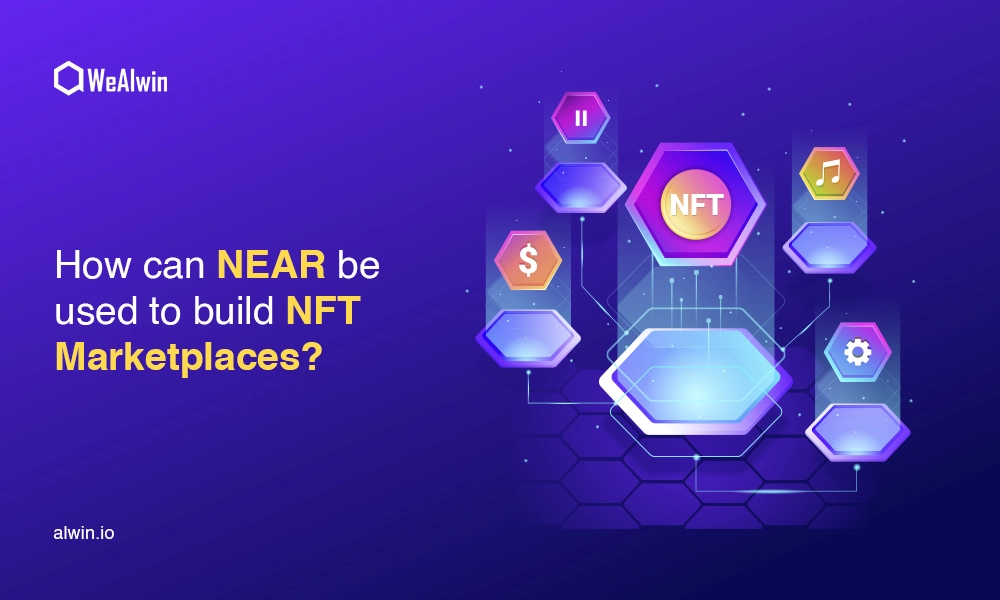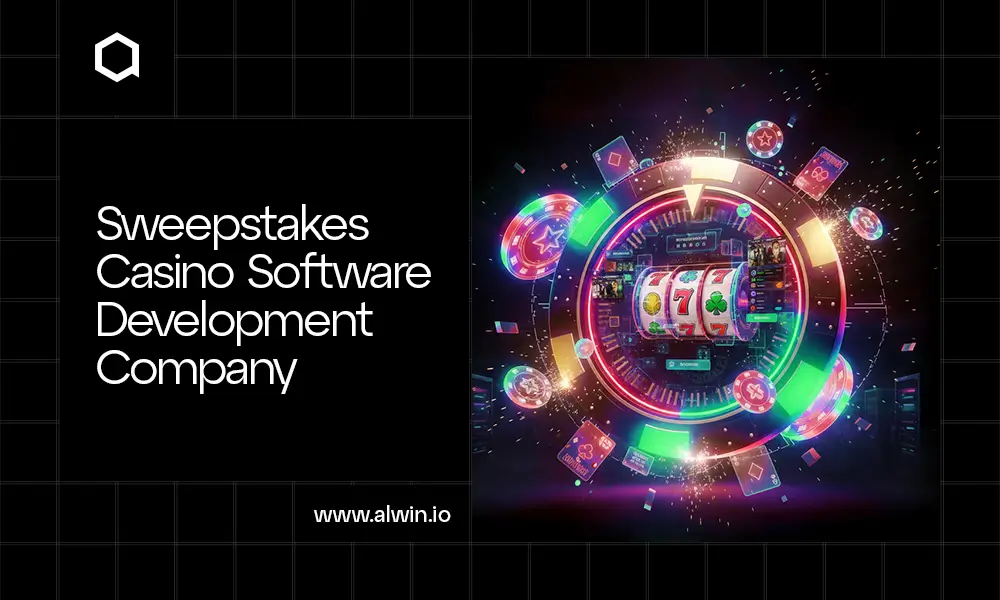The digital world is changing faster, Non-Fungible Tokens (NFTs) have emerged as a revolutionary way to buy, sell, and trade digital assets securely over the blockchain. The NEAR Protocol, known for its exceptional scalability, decentralization, and user-friendly interface, offers an ideal platform for developing NFT marketplaces. This blog explores the potential of the NEAR Protocol in empowering creators, artists, and entrepreneurs to launch their own NFT marketplaces, tapping into the booming digital economy.
Overview of NEAR Protocol:
NEAR Protocol is a blockchain platform designed to provide a scalable, secure, and developer-friendly environment for building decentralized applications (dApps) and deploying smart contracts. Launched in 2020, NEAR aims to address the scalability challenges faced by existing blockchain platforms while also prioritizing usability and accessibility for developers.
It employs a sharded, proof-of-stake consensus mechanism to achieve high throughput and low transaction fees, making it suitable for a wide range of applications, from simple token transfers to complex decentralized finance (DeFi) protocols and gaming platforms. NEAR also offers features such as native interoperability with other blockchains, intuitive developer tools, and a strong emphasis on user experience to foster adoption and innovation within the ecosystem.
Key Features of NEAR Protocol:
NEAR Protocol boasts several distinctive features that set it apart in the crowded blockchain space:
Sharding Technology: This allows the network to process transactions and store data more efficiently, and increases throughput as the network grows.
Nightshade Consensus: A unique approach to blockchain consensus that combines elements of both Proof-of-Stake (PoS) and sharding to ensure high security and scalability.
Cross-chain interoperability: NEAR facilitates seamless interaction with other blockchain networks, enhancing its utility and allowing for a wider range of applications.
Developer and user-friendly: With a focus on simplifying the development process, NEAR provides tools and resources that make blockchain technology more accessible to developers and users.
Usability First: NEAR prioritizes usability for developers and end-users, focusing on creating applications that are easy to use and capture sustainable value. The protocol enables developers to onboard users seamlessly, without requiring immediate interaction with blockchain concepts or wallets.
End-User Usability:
Simple Onboarding: Developers can take actions on behalf of users, streamlining the onboarding process.
Easy Subscriptions: Contract-based accounts allow for the creation of subscriptions and custom permissions.
Familiar Usage Styles: NEAR's economic model hides infrastructure costs, providing a familiar web usage experience.
Predictable Pricing: Transactions on NEAR are priced in simple terms, ensuring predictable pricing for end-users.
Developer Usability:
Familiar Languages: NEAR supports Web Assembly (WASM) and Rust, making it accessible to developers familiar with popular programming languages.
Robust Tooling: NEAR's development suite offers a unified set of tools for easy development, testing, and deployment of applications.
Developer Business Models: NEAR Protocol supports developers by rewarding them based on the usage of open components they create for the ecosystem.
Predictable Pricing: Developers experience predictable pricing for transactions on the platform.
Scalability Second: NEAR utilizes a sharding approach to scale the network dynamically as additional nodes participate. This allows for continuous scalability as demand increases, optimizing performance for transactions that touch multiple shards.
Efficient Development and Evolution: NEAR ensures efficient development and evolution of the platform while maintaining decentralization. The protocol is designed to iterate quickly while maintaining community oversight, ensuring competitiveness and relevance.
Real Decentralization: NEAR prioritizes real decentralization by allowing permissionless participation from prospective node operators. The staking mechanism encourages broad participation and lowers barriers to entry, enhancing both decentralization and scalability.
Benefits of NEAR Protocol:
Sustainability: The infrastructure of NEAR is built with environmental sustainability in mind, utilizing energy-efficient consensus mechanisms. This ensures that NFT marketplaces built on NEAR contribute to a sustainable blockchain ecosystem.
Cost-effective: Developing NFT marketplaces on NEAR can be cost-effective due to its low transaction fees and scalable infrastructure. This enables developers to launch and maintain their platforms without incurring high operational costs.
User-friendly: NEAR prioritizes user experience, providing intuitive development tools and interfaces. This makes it easier for developers to create NFT marketplaces with smooth navigation and seamless interactions, enhancing the overall user experience for both creators and collectors.
Secure: NEAR's robust security features and focus on smart contract safety help mitigate risks associated with NFT transactions, such as counterfeit or fraudulent activities. By leveraging NEAR's security protocol, NFT markets can be created by developers with user assets and data privacy as a top priority.
Pragmatic: NEAR's pragmatic approach to blockchain development emphasizes real-world applications. This makes it well-suited for building NFT marketplaces that address specific industry needs and challenges, offering innovative features and functionalities tailored to creators, collectors, and traders.
Consult with our business experts to develop your NFT Marketplace on NEAR! Chat with us on WhatsApp
Extensive Benefits of NEAR NFT Marketplace Development:
JavaScript-Based Development: Developers use JavaScript for efficient coding, avoiding the need to learn new languages.
Community-Built Components: Leveraging NEAR's community-built components enhances marketplace features and competitiveness.
Compatibility with Web3 Transition: NEAR NFT marketplaces accommodate both Web2 and Web3 users, easing the transition and broadening accessibility.
Decentralization: NEAR's decentralization ensures transparent and immutable transaction records, fostering trust in the marketplace ecosystem.
Utilization of Provisions: NFT marketplaces benefit from NEAR's low cost, high speed, and scalability, even if built on other blockchains like Ethereum.
Availability Across Interfaces: NEAR-based NFT marketplaces are accessible via web browsers, mobile apps, and other devices, expanding audience reach.
Tech Components associated with NEAR NFT Marketplace Development:
NEAR SDKs: NEAR SDKs provide tools, libraries, and documentation for app creation on NEAR. They facilitate smart contract development, blockchain interaction, and feature integration in NFT marketplaces.
Gitpod for NEAR: Gitpod for NEAR is an IDE enabling quick setup of development environment for NEAR projects. It fosters collaboration, code writing, and testing in a cloud-based space, enhancing development efficiency.
NEAR Wallet: NEAR Wallet is essential for user interaction with NEAR-based NFT marketplaces. It offers a user-friendly interface for account management, token storage, and secure transactions, enabling seamless onboarding and token management.
NEAR Explorer: NEAR Explorer is a blockchain explorer tool providing insights into NEAR blockchain activities. It enables monitoring and analysis of transactions, blocks, contracts, and accounts, ensuring transparency, audibility, and debugging during development and deployment.
NEAR Command-line Tools: NEAR's command-line tools offer developers a convenient way to interact with the NEAR Protocol. They facilitate contract deployment, local smart contract testing, blockchain data querying, and more, simplifying NFT marketplace troubleshooting and development duties on NEAR.
How to Build a NEAR NFT Marketplace?
Set Up Development Environment:
Start by setting up your development environment using NEAR SDKs and tools such as Gitpod for NEAR. These provide essential resources for writing smart contracts, developing front-end interfaces, and testing your NFT marketplace application.
Design Smart Contracts:
Design and develop smart contracts to manage the creation, ownership, and transfer of NFTs on the NEAR blockchain. Use NEAR SDKs, such as Rust-based tools like near-bindgen, to write smart contracts securely and efficiently. Define functionalities such as minting NFTs, transferring ownership, and managing royalties.
Integrate NEAR Wallet:
Integrate the NEAR Wallet into your NFT marketplace to enable users to interact with the platform securely. Utilize NEAR Wallet SDKs and APIs to facilitate user authentication, token management, and seamless transactions within the marketplace.
Develop Frontend Interface:
Develop a user-friendly front-end interface for your NFT marketplace using web development technologies such as HTML, CSS, and JavaScript. Utilize NEAR Wallet APIs and NEAR Explorer for functionalities like displaying NFTs, browsing collections, and interacting with smart contracts.
Implement Marketplace Features:
Implement essential features for your NFT marketplace, such as browsing NFTs, creating listings, bidding on auctions, and purchasing NFTs. Utilize NEAR command-line tools for deploying and testing smart contracts, and integrate NEAR Explorer for monitoring blockchain activities.
Ensure Security and Compliance:
Ensure security and compliance by following best practices for smart contract development and adhering to NEAR's guidelines for decentralized applications. Implement measures such as access controls, data encryption, and auditing to protect user assets and ensure the integrity of transactions.
Test and Deploy:
Thoroughly test your NFT marketplace application to identify and resolve any bugs or issues. Use NEAR's testnet environment for conducting testing in a simulated blockchain environment. Once testing is complete, deploy your NFT marketplace to the NEAR mainnet for public access.
Market and Launch:
Market your NFT marketplace to attract users and creators to the platform. Leverage social media, online communities, and partnerships to promote your marketplace and drive adoption. Continuously iterate on your platform based on user feedback and market demand to enhance the user experience and expand your user base.
Why Build an NFT Marketplace on NEAR?
Scalability: NEAR's scalable infrastructure handles high transaction volumes without performance loss, ensuring NFT marketplaces can grow seamlessly.
Low Cost: NEAR Protocol's low transaction fees make NFT trading affordable, fostering increased participation and liquidity in the ecosystem.
Interoperability: NEAR supports cross-chain asset transfers, enabling NFT marketplaces to interact with external platforms, enhancing utility and value.
User-Friendly Development: NEAR offers intuitive tools and JavaScript-based programming, simplifying NFT marketplace creation without learning new languages.
Security: NEAR prioritizes smart contract safety, mitigating risks like fraud, and ensuring users' confidence in their digital assets' integrity.
Community Support: NEAR's active community provides resources and components for NFT marketplace development, driving innovation and adoption.
How NEAR Protocol Support NFT Development?
NEAR Protocol streamlines the NFT development process through several key features. Primarily, its sharding mechanism significantly increases scalability, allowing a higher volume of transactions per second (TPS) without compromising on speed or inflating costs.
This is crucial for NFT marketplaces, where transaction speed and cost-effectiveness are paramount. Additionally, NEAR offers human-readable accounts to make remembering them easier. Accounts now have addresses rather than lengthy strings of random letters. User-friendly account names instead of the cryptographic wallet addresses common on other platforms, enhance the user experience. Moreover, its progressive security features and cross-chain interoperability broaden the horizon for NFT market creators, fostering a more inclusive and expansive digital asset ecosystem.
Comparison of NEAR Protocol with other Blockchain Platforms for NFTs:
Compared to blockchain giants like Ethereum, NEAR Protocol offers a more scalable and cost-effective solution for NFT marketplace development. While Ethereum struggles with high gas fees and network congestion, NEAR's sharding technology circumvents these issues, providing a smoother experience for both developers and users. Furthermore, NEAR's emphasis on a user-friendly interface makes it accessible to a broader audience, unlike the somewhat technical barriers present in other platforms.
Future of NFT Marketplaces on NEAR Protocol:
Looking ahead, the future of NFT marketplaces built on the NEAR Protocol appears promising, with several potential trends and innovations shaping the landscape.
Potential trends and innovations
Emerging trends include the integration of artificial intelligence to personalize user experiences, the use of augmented reality to showcase NFTs in new ways, and the development of cross-chain marketplaces to enhance liquidity and access. These innovations could significantly enhance the value proposition of NFT marketplaces, attracting both creators and collectors.
Role of decentralization in shaping the NFT ecosystem
Decentralization plays a pivotal role in the evolution of the NFT ecosystem. By ensuring that control and ownership are distributed among its users, the NEAR Protocol fosters a transparent and equitable environment for NFT trading. This decentralization helps to reduce the risks of censorship and central point failure, promoting a resilient and dynamic marketplace that can adapt to the changing needs and desires of the community. As the ecosystem matures, the principles of decentralization could lead to more democratic governance models and innovative financial structures, further enriching the NFT landscape.
Conclusion:
The NEAR Protocol stands out as a robust foundation for developing NFT marketplaces, offering unparalleled advantages in terms of scalability, speed, and user experience. By leveraging its unique features—such as sharding technology for enhanced capacity and Nightshade for reduced transaction costs—developers are well-equipped to build sophisticated, efficient, and user-friendly digital asset platforms. As blockchain technology continues to evolve, the NEAR Protocol's commitment to decentralization and innovation positions it as a key player in the future of NFT marketplaces. Choosing the right NFT Marketplace Development Company is crucial and WeAlwin is the right choice.



